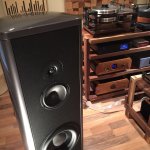Respectfully, LVB I don't understand why you continue to make such claims and are unwilling to provide any logical explanation supporting your supposition. I would only presume you are either seriously not reading the posts made to you or you are just yanking peoples chains for sport. Please allow me to make my point on last time and I will try to do so as simply as possible to facilitate things.
Where I agree
Clearly Toole has shown a positive correlation coefficient between blind testing and measurements. One of those measurements is FR.
Where I disagree
However, I have never seen any credible empirical evidence related to blind testing, or other wise, making a definitive determination that optimization of FR is superior to time response. I have also never seen such evidence confirm that the correlation coefficient between positive blind test results and FR remains positive beyond a base level acceptable to the human ear. I, in fact, have questioned whether the correlation coefficient turns negative if FR is taken to an extreme. The O'tool work in no way shape or form draws such conclusions and doing so rings hallow. You are the only one I recall making such a claim so conclusively and yet you will not address the question at hand yet you keep repeating your belief. Why not do a fellow Shark a solid and help us get as smart as you.
Paul,
It will be a much more constructive discussion if you try and tame your condescending tone. It does not go well with your “presume” attempt to learn.
Toole has shown clearly in his research that the only correlation between people preferences and perception of sound quality in loudspeakers derive from frequency response related behavior and not time/phase ones. Already in the 60’s the BBC have found no correlation between time coherency and “good” sound, and that is why most British loudspeakers (still) use high-order XO slops (Go and read Alan Shaw of Harbeth take on the subject - http://www.harbeth.co.uk/usergroup/...erence-A-Desirable-Attribute-In-A-Loudspeaker). It is all out there, you just need to make the effort and read the materials (but you didn’t even bother to watch the video I sent you, it is a lot easier just to harass me on-line).

